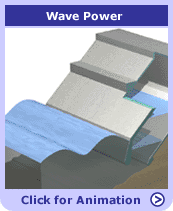| Wave Power | ||||||||||
Visualize January/February 2002
How to get watts from ocean waves. For decades, scientists have been trying to tap wave power as a source of renewable energy. According to the World Energy Council—an international consortium promoting sustainable energy—ocean waves could supply twice as much electricity as the world now consumes. But wave action is so dispersed, it’s difficult to harvest this power economically.Wavegen, an Inverness, Scotland-based company, is trying. In November 2000 it installed the world’s first commercial system to generate electricity directly from the surf. Located near the town of Portnahaven on the Scottish island of Islay, Wavegen’s system—called the Land-Installed Marine-Powered Energy Transformer, or Limpet—can generate 500 kilowatts of power reliably, enough for about 400 homes. Researchers have developed several mechanisms for capturing wave energy, including tapered-channel systems that funnel waves into a turbine, underwater turbines powered by currents, and float systems that rise and fall on the water’s surface, driving pistons that convert the motion into energy. Wavegen chose an oscillating water column approach. Waves rolling into shore push up the water level inside a large, partially submerged concrete chamber built into the shoreline. The rising water forces the air trapped in the chamber through a hole and into the mouth of a turbine. When the waves recede, the falling water level in the chamber sucks air through the turbine in the opposite direction. The key to the system is its use of a so-called Wells turbine, whose blades rotate in the same direction regardless of airflow direction. The spinning turbine drives a generator that produces electricity. Limpet is seen as a key test bed for furthering developments in wave energy technology. Indeed, most of the progress in wave power is occurring in countries with lots of coastline: Britain, Japan, Australia and New Zealand. In the States, work on the technology slowed with U.S. Department of Energy budget cuts in the 1980s. But ocean-wave energy is still on the radar screen in California, where the California Energy Commission is assessing its viability and San Diego State University is putting together a consortium that could one day bring wave power to American shores. Tracy Staedter is the managing editor at Technology Review.
| ||||||||||
| Home | Current Issue | Archive | ||||
